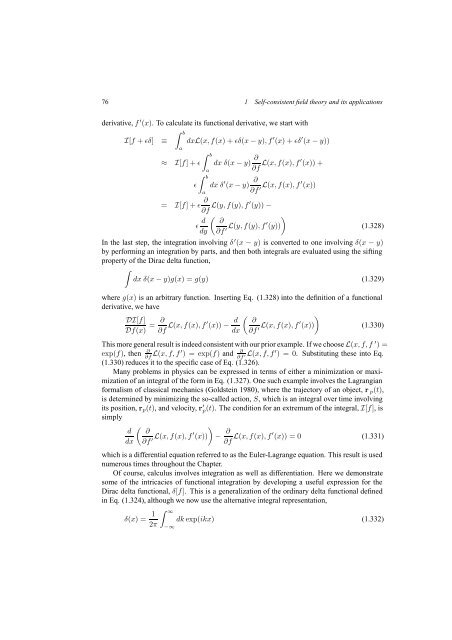Self-Consistent Field Theory and Its Applications by M. W. Matsen
Self-Consistent Field Theory and Its Applications by M. W. Matsen
Self-Consistent Field Theory and Its Applications by M. W. Matsen
Create successful ePaper yourself
Turn your PDF publications into a flip-book with our unique Google optimized e-Paper software.
76 1 <strong>Self</strong>-consistent field theory <strong>and</strong> its applications<br />
derivative, f ′ (x). To calculate its functional derivative, we start with<br />
I[f + ɛδ]<br />
≡<br />
≈<br />
∫ b<br />
a<br />
dxL(x, f(x)+ɛδ(x − y),f ′ (x)+ɛδ ′ (x − y))<br />
I[f]+ɛ<br />
ɛ<br />
∫ b<br />
a<br />
∫ b<br />
a<br />
dx δ(x − y) ∂<br />
∂f L(x, f(x),f′ (x)) +<br />
dx δ ′ (x − y) ∂<br />
∂f ′ L(x, f(x),f′ (x))<br />
= I[f]+ɛ ∂<br />
∂f L(y, f(y),f′ (y)) −<br />
ɛ d ( )<br />
∂<br />
dy ∂f ′ L(y, f(y),f′ (y))<br />
(1.328)<br />
In the last step, the integration involving δ ′ (x − y) is converted to one involving δ(x − y)<br />
<strong>by</strong> performing an integration <strong>by</strong> parts, <strong>and</strong> then both integrals are evaluated using the sifting<br />
property of the Dirac delta function,<br />
∫<br />
dx δ(x − y)g(x) =g(y) (1.329)<br />
where g(x) is an arbitrary function. Inserting Eq. (1.328) into the definition of a functional<br />
derivative, we have<br />
DI[f]<br />
Df(x) = ∂<br />
∂f L(x, f(x),f′ (x)) − d ( )<br />
∂<br />
dx ∂f ′ L(x, f(x),f′ (x))<br />
(1.330)<br />
This more general result is indeed consistent with our prior example. If we choose L(x, f, f ′ )=<br />
exp(f), then ∂<br />
∂f L(x, f, f ′ )=exp(f) <strong>and</strong><br />
∂<br />
∂f<br />
L(x, f, f ′ )=0. Substituting these into Eq.<br />
′<br />
(1.330) reduces it to the specific case of Eq. (1.326).<br />
Many problems in physics can be expressed in terms of either a minimization or maximization<br />
of an integral of the form in Eq. (1.327). One such example involves the Lagrangian<br />
formalism of classical mechanics (Goldstein 1980), where the trajectory of an object, r p (t),<br />
is determined <strong>by</strong> minimizing the so-called action, S, which is an integral over time involving<br />
its position, r p (t), <strong>and</strong> velocity, r ′ p(t). The condition for an extremum of the integral, I[f], is<br />
simply<br />
( )<br />
d ∂<br />
dx ∂f ′ L(x, f(x),f′ (x)) − ∂<br />
∂f L(x, f(x),f′ (x)) = 0 (1.331)<br />
which is a differential equation referred to as the Euler-Lagrange equation. This result is used<br />
numerous times throughout the Chapter.<br />
Of course, calculus involves integration as well as differentiation. Here we demonstrate<br />
some of the intricacies of functional integration <strong>by</strong> developing a useful expression for the<br />
Dirac delta functional, δ[f]. This is a generalization of the ordinary delta functional defined<br />
in Eq. (1.324), although we now use the alternative integral representation,<br />
δ(x) = 1 ∫ ∞<br />
dk exp(ikx) (1.332)<br />
2π<br />
−∞
















